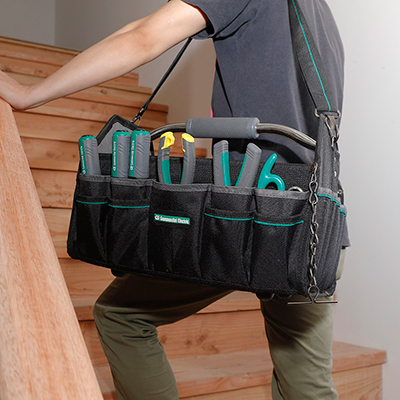How to Wire an Outlet

Published February 28, 2025
Running electrical wires behind your walls is a great way to add an additional outlet or switch right where you need it. This guide explains how to wire an outlet and provides steps for running basic nonmetallic (NM) electrical wire behind the walls.
Difficulty:
Advanced
Duration:
Over 1 day
Table of Contents
Turn Off the Electricity
Mark for the Electrical Box
Drill a Hole in the Ceiling or Floor
Cut the Opening for the Electrical Box
Run the Cable
How to Wire an Outlet Past a Fire Block
Turn Off the Electricity

- Open your breaker panel and turn off the power to the outlet you'll use before wiring an outlet.
- Use a voltage tester to check if power is off when wiring an electrical outlet. Always be sure to test the meter on a live circuit before you check to make sure the circuit that you'll be using has no power.
Mark for the Electrical Box

- Use a stud finder to ensure the location for your new device isn’t adjacent to a stud.
- Hold the electrical box to the wall in the location where it will be installed.
- Trace the box with a pencil to mark the area to be cut. Use a level to ensure the outline is straight.
Drill a Hole in the Ceiling or Floor

- Before wiring an outlet, check the area where you are running cable to ensure there are no obstructions in the way. It's better to check now than to patch later. If you’re running cable through the ceiling, use a screwdriver or power drill with an 1/8-inch bit to carefully drill a hole through the ceiling above the new wall box location. If you’re running cable through your basement or crawl space, drill into the baseboard or floor right next to the baseboard instead.
- Insert a stiff wire or straightened coat hanger into the hole.
- In your attic or basement, look for a 2 x 4-inch beam adjacent to the protruding stiff wire. In an attic, this beam is the top of the wall, known as the top plate. In a basement, it’s the bottom of the wall, known as the bottom plate.
- If the 2 x 4 is under a piece of plywood, or covered in some other way,
measure 2 1/2 inches from the reference wire toward the 2 x 4 and drill there. That should put the hole in the middle of the plate. - Check with a flashlight to make sure there are no electrical wires or plumbing pipes behind the walls where you will be wiring an electric outlet.
Cut the Opening for the Electrical Box

- Drill a 1/2-inch starter hole at one corner of your electrical box outline.
- Starting at the hole, cut along the outline with the drywall saw. Do not cut too deep with the drywall saw in case there is a cable that you didn't see. It’s okay if the edges of the opening are rough. You can conceal the opening with a wall plate.
Run the Cable

- If you’re going through the attic when wiring an outlet, use the spade bit to drill a hole through the top plate, directly above the new electrical box location. If you’re running cable through a basement or crawlspace, drill a hole in the bottom plate directly below the box.
- Feed your fish tape into the wall opening, pushing it up into the hole you made in the top plate. If you’re running cable through a basement or crawl space, push it down to the hole in the bottom plate. You may need to insert the end of a coat hanger into the hole to pull the end of the fish tape through the hole.
- Should you encounter a fire block, proceed with Step 6. If you do not encounter a fire block, go directly to Step 7.
How to Wire an Outlet Past a Fire Block

A fire block is a horizontal beam of wood running between the wall studs. You can drill a hole through the fire block or create a notch to accommodate the wire.
To drill a hole:
- Insert a long, flexible drill bit through the opening for the electrical box and position it on the center of the fire block.
- Drill through the fire block.
To cut a notch:
- Cut into the drywall at the location of the wall block.
- Use a sharp chisel and a hammer to cut a 3/4-inch wide x 1-inch deep notch in the fire block as a conduit for the cable. Pull the cable past the fire block following the instructions in Step 7.
- After you've fished the cable through the notch, cover the notch with a metal nail plate to protect the cable from nail damage.
- Patch over the drywall hole.
Pull a Cable Through the Wall

- From the attic, basement or crawl space, use electrical tape to secure one end of the cable to the hook on the fish tape.
- At the wall opening, carefully and steadily retract the fish tape, pulling the cable to the wall opening. Don’t create friction that can tear the cable’s sheathing, and carefully avoid kinks that could damage the cable.
Electrical Wiring Tips

- Decide whether to pull power for your new outlet, an existing outlet or directly from your breaker panel. Either way, double check that adding a new device won’t overload the circuit when wiring an outlet.
- Diagram your wiring path. Often the simplest approach is to run cables to either the attic directly above the new outlet or switch, or to a basement or crawl space below.
- If you aren’t able to install electrical wiring behind walls due to ductwork or plumbing, an alternative solution is to conceal wires using a cable raceway, which runs along the surface of walls and can be painted to blend in with your decor.
- Be sure when wiring an electrical outlet to turn off the electricity at the breaker panel to the outlet or circuit breaker you will draw power from. Use a voltage tester to confirm the power is off at the outlet or breaker.
- Make sure a new device will not overload the circuit from which you draw power.
Wire an Existing Outlet

If you want to replace an outlet without tearing open a wall, follow these steps:
- Always turn off the power to the circuit at the main electrical panel and confirm it is off using a voltage tester before beginning any work.
- Unscrew and remove the cover plate and gently pull the outlet out of the electrical box.
- Loosen the terminal screws on the sides of the old outlet and disconnect the wires. There are usually three wires: a black (hot) wire, a white (neutral) wire and a green or bare (ground) wire.
- Inspect the existing wire ends for signs of weakness or damage. If they are OK, use them to connect to the new outlet. If not, cut the ends off. Strip about 3/4 inch of insulation from the ends of the wires to expose fresh copper. Bend new hooks at the end of the wires with needle nose pliers or a bending hole on a wire stripper.
- Connect the wires to the new outlet. Typically, the black or red wire goes to the brass-colored screw (hot), the white wire to the silver-colored screw (neutral) and the green or bare wire to the green screw (ground). Wrap the hook around the screw in a clockwise direction.
- Push the outlet back into the electrical box and secure it with the screws.
- Screw the cover plate back into place and turn the power back on. Use a voltage tester to make sure the outlet is working.
Learning how to wire an outlet can be done with the right tools and materials. Ready to start your project? The Home Depot has options to deliver online orders when and where you need them.



























